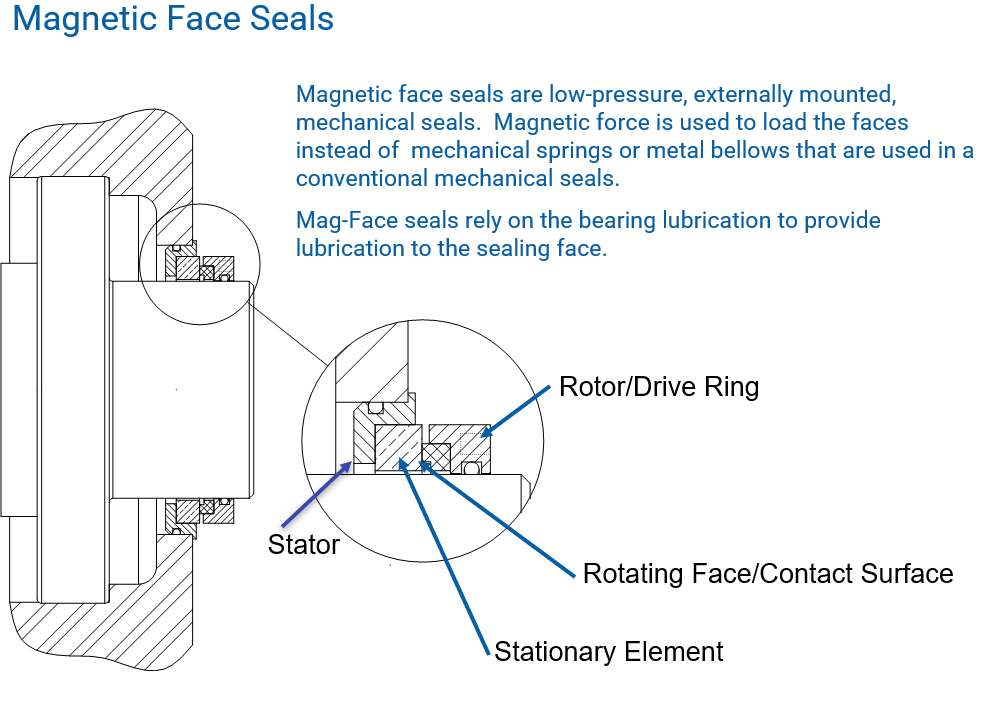Performance Showdown: SEPCO EXP Expeller Seals vs. Magnetic Face Bearing Seals
 ABSTRACT
ABSTRACT
To understand the benefits of a SEPCO EXP Compound Expeller Seal over selecting a competitor’s Magnetic Face Bearing Seal, one must understand the scope of duty for bearing isolators. Bearing Isolators retain a lubricating fluid within the bearing housings on various rotating equipment. Bearing Isolators keep a lubricant in the bearing housing and prevent the ingress of any outside contamination, such as water, noncompatible chemicals, biological material, dust, and other forms of debris. Bearing Isolators are not limited to merely sealing or isolating the bearings on equipment as their name may suggest, but also aid in extending the life of equipment bearings by reducing wear from misalignment.
The fluid sealing industry’s end users have been misled and negatively impacted over the years by many companies attempting to sell technology without grounding in applied science. This brief research paper examines the theoretical flaws of Magnet Face Bearing Seals to assist potential clients of Bearing Isolator manufacturers in making informed decisions. It presents concrete evidence of those hypothetically poor engineering designs. A competitor’s Magnetic Face Bearing Seal’s engineering design is evaluated to determine if their hypothesis of having one (1) atmosphere of pressure on bearing housing oil can lubricate the seal in question. SEPCO’s EXP Compound Expeller Seal’s engineering design is reviewed to determine its possible advantages or a competitor’s Magnetic Face Bearing Seal. Both seals are thoroughly examined physically, and photos provide context to all components. Experimental tests and various application cases are studied to directly compare the performance of these two styles of Bearing Isolators, followed by an explanation of budgetary implications for a possible client.
INTRODUCTION
One of the primary purposes of this research paper is to demonstrate the theoretical and real-world infeasibility of Magnetic Face Seals even in a flooded environment where “flooded” and even “bath” conditions are deemed appropriate applications by the competitor. The second primary goal of this research is to highlight how Compound Expeller Seals (SEPCO EXPs) achieve far greater success, not just in design theory but also by providing critical field study results when installed on equivalent applications to Magnetic Face Seals.
The motivation of any research SEPCO conducts is to develop the most effective and cost-efficient technology for end users, not to create attractive product lines on a data sheet that is not grounded in reality and does not perform to the standards advertised. It is imperative that our clients’ facilities are not made to be a research laboratory, it is possible that the same may not said of our competitors’ motives. This approach to research and developing cutting-edge fluid sealing technology may be the underlying issue with our competitor’s success with new bearing isolators.

Bearing isolators, in general, have extended the life of equipment from approximately two (2) years when the reliability revolution started; we were getting around six months MTBF to up to eight (8) years in most cases. This crucial product considerably keeps out contaminants such as water and debris and reduces wear. While knowing bearing isolators can improve the lifespan of equipment in a plant, they should be approached with the mindset that they are an investment designed to protect bearings and mechanical seals. If properly designed (not all designs are the same) and applied, they will improve conditions and reduce total cost / mean time between replacements for an end user. If there is an inherent issue with the bearing isolator, it can exacerbate existing problems by generating excess heat, leaking, or allowing outside contaminates into the bearing housing.
While this research paper is not an exhaustive case/field study, the implications of SEPCO’s findings provide a resoundingly clear answer for why Compound Expeller seals, “EXPs,” are far superior to Magnetic Face Bearing Seals. Photographs, costs, lifespans, and other results are compared side-by-side to compare these two (2) bearing isolator designs and their results to end users. Woody Nepa, who aided SEPCO in developing the EXP bearing isolator, was interviewed and provided expert-level background information. Chris Tindell is also responsible for providing direct client results from years of experience in the field as a reliability specialist and purchasing manager before making a career move to SEPCO as a sales manager. The author of this paper, Nicholas Stidham, has provided various photographs.
TECHNICAL LITERATURE


Several key elements are involved in successfully sealing fluids with a mechanical seal. While this research paper focuses on bearing isolators, a great example of one of the key elements mentioned above is the use of barrier fluid in mechanical seals. Mechanical seals rely on “faces,” typically a rotary and stationary component within the seal making contact with each other to prevent a product or contaminant from crossing a barrier; however, those faces (regardless of the material used) must have lubrication to avoid overheating and excessive wear from friction generated by the rotating equipment they are installed on, which would inevitably lead to a premature seal failure. For a “barrier fluid” such as SEPCO’s “STL” synthetic oil or any cooling lubricant to cover the entire surface area of the faces in a mechanical seal that contacts a positive pressure, greater than or equal to one (1) atmosphere above stuffing box (in this case bearing housing) pressure must be applied to force the barrier fluid across them. “Barrier fluids are usually pressurized 15-30 psi above the seal chamber pressure.” (Low, 1) This understanding that is readily available to any fluid sealing engineer is vital to success with any form of mechanical seal, leading to the hypothesis that a Magnetic Face Bearing Seal has a fatal design flaw.
Woody Nepa cited multiple field studies on bearing failures based on end-user information and found the following:
- Only ten percent (10%) of bearings reached their L10 life before requiring replacement.
- By definition, ninety percent (90%) of bearings should reach the L10 length of life; thus, eighty percent (80%) of failures are premature.
- Sixty-three percent (63%) of bearing failures are due to wear from insufficient lubrication, including forty-eight percent (48%) of failures due to particle contamination.
Mr. Nepa has also stated that Magnetic Face Bearing Seals have the following issues when tested in our laboratory as well as when observed in the field:
- Friction-based seals consume power, increasing the costs of asset ownership.
- Magnetic Face Bearing Seals generate excessive heat due to being contact seals by design. Their design relies on friction and has been measured in use at temperatures greater than two hundred forty degrees Fahrenheit / ninety-six degrees Celsius (240* F / 96* C).
- Magnets can be degaussed and fail under high temperatures for extended periods, reducing reliability on systems that cannot afford such risks. Thus, misleading marketing should be investigated further when an end user selects a bearing isolator manufacturer.
- To function properly, Magnetic Face Bearing Seals must leak or be fully submerged to have even a fraction of lifespan; however, even in a bath or flooded environment, there is no barrier fluid pressure to provide adequate lubrication to the face of the bearing isolator, which leads to leaking, contamination, and a premature bearing isolator failure.
Mr. Nepa followed up these observations of Magnetic Face Bearing Seals with SEPCO laboratory testing and field observations of SEPCO’s Compound Expeller Bearing Isolators EXPs and the results were as follows:
- SEPCO EXPs have a verifiable rated life of 175,000 hours
- EXPs require no break-in period to achieve an effective seal with no leaks.
- Expels contaminates by adding energy to remove them.
- By design, SEPCO EXPs have redundant static sealing, providing end users with consistent performance and extended equipment reliability.
- Reduced cost of ownership by limiting the following:
- Equipment damage/bearing and bearing lubricant replacement.
-Collateral damage
-Energy costs.
-Upfront prices.
METHODOLOGY
Further information was gathered after these theoretical proofs, field observations, and laboratory tests. Based on the information above about these two engineering design approaches to bearing isolators, a physical inspection was necessary to verify the hypothesized genesis of the egregious failures of a Magnetic Face Bearing Seal compared to the noteworthy success of the SEPCO EXP Compound Expeller Bearing Isolators. The approach to this physical analysis was non-destructive and observational.
RESULTS
The following photographs highlight the initial modes of the magnetic face bearing seals failing, whereas SEPCO’s EXP compound expeller bearing isolators excel. Nicholas Stidham from SEPCO’s Engineering Department took all images in SEPCO’s Failure Analysis Laboratory. All photographs have critical points about the observations in their respective footnotes. The following results matched SEPCO’s hypotheses, reiterated throughout this research paper.
NOTE:
SEPCO offers its clients failure analysis as a free service to provide information that may reduce the mean time between seal replacements. This is only one part of SEPCO’s reliability tracking program, the “SAMS” Sealing Application Management System.
CONCLUSION
Bearing isolators are only a small part of a system that allows the equipment to perform at its most optimum level. Yet, they are vital for the success of any facility with rotating equipment. As inconsequential as they may seem, bearing isolators affect daily life for billions globally, from automobiles and aircraft to the food industry to the pharmaceutical manufacturers down the street working daily to save lives. With this in mind, end users should take selecting bearing isolators very seriously. SEPCO has tirelessly completed multiple forms of research to determine the design that would best serve its end users. Failure is not an option for the applications SEPCO seals. If an EXP Compound Expeller Bearing Isolator is included in a system, the client would see significantly improved system reliability and reduced budgetary expenses.
If you now feel bearing isolators are more important to your team’s success and your process as a whole, please do not hesitate to contact the SEPCO Engineering Department to assist you in answering your fluid sealing needs.
WORKS CITED
Bearing Isolator Photographs. 13 Mar. 2024. SEPCO – Alabaster, Alabama.
Tindell, Chris, and Nicholas Thomas Stidham. “Industry Expert Interview.” 14 Mar. 2024.
“EXP Bearing Isolator.” SEPCO, Inc., 6 Mar. 2024, www.sepco.com/products/bearing-protection/bearing-isolators/exp-bearing-isolator/.
Low, Alfred. “Basics of Buffer and Barrier Seal Support Plans.” www.swagelok.com , 2024, https://www.swagelok.com/-/media/Distributor-Media/O-S/Singapore/Services/Basics-of-Buffer-and-Barrier-Seal-Support-Plans.ashx?la=en&hash=13574947BB37178D63BCB5839747AA72EDFB12A7. Accessed 2024.
Nepa, Woody, and Nicholas Thomas Stidham. “Industry Expert Interview.” 13 Mar. 2024.
ABOUT THE AUTHOR
Nick Stidham – Product Application Designer and CAD Draftsman
SEPCO Engineering Department
email: nicks@sepco.com / phone: 205-403-7500, ext. 7612
Associate in Applied Science (A.A.S), Advanced Engineering Design Technology – Bevill State Community College ’20
 SEAL CONNECT
SEAL CONNECT
 Find Your Sealing Solution
Find Your Sealing Solution